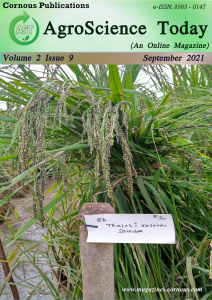Wax moth, wasp, hornets, small hive beetle and ants are insect pests of honeybees. American and European foulbrood are bacterial diseases. Thai sac brood is viral disease. Nosemosis and amoebic disease is caused by protozoan. Tracheal mite, Varroa mite and brood mite is non-insect pest of bees. American foulbrood, European foulbrood, Thai sac brood, Nosemosis and amoebic disease are the diseases of honey bees. Make weak colony strong by uniting 2 colonies, regular cleaning of bottom board and increased monitoring of bee hive are management practices for pest and diseases of honey bees.
Cover crops help to increase the productivity of future row crops by enhancing the physical, chemical, and biological qualities of the soil. The goal of this essay is to analyze current advancements in cover crop practice in terms of potential benefits and drawbacks for annual crop yield and long-term soil quality. A cover crop's desirable characteristics include its ability to establish quickly under less-than-ideal conditions, provide adequate dry matter or soil cover, fix atmospheric nitrogen (N), establish a deep root system to facilitate nutrient uptake from lower soil depths, and produce organic matter with a low carbon/nitrogen (C/N) ratio. Cover crops can be leguminous or non-leguminous. Leguminous cover crops supply a significant quantity of biologically fixed nitrogen to the primary crop, as well as a low C/N ratio that facilitates decomposition. Legume cover crops can also assist increase the concentration of plant nutrients in the soil's surface layers by absorbing low accessible nutrients in the soil profile. Because some non-leguminous cover crops have a higher N scavenging capability than leguminous crops, and because the growth of these scavenging grass cover crops is often limited by N deficit, planting grass/legume mixes appears to be the ideal method for maximizing cover crop advantages.
Historically, highland pastoralism (Doksa) has been the predominant means of livelihoods in Zanskar which is primarily based on transhumant practices and entails cyclical migration of cattle from lowlands to highlands for judicious exploitation of seasonal reachable pastures at high altitudes in the Himalayas. This study demonstrates the Doksa activities, consequential fatigue and drudgery and gender discriminations of the pastoralist women and strategic interventions to solve the problems. Pastoralist women undoubtedly perform all the Doksa activities including milking twice a day, churning yoghurt, making and packing butter, drying chhurpey, collecting dung and making dung cakes etc. Due to the lack of modern techniques, the pastoral women are still sticking to their traditional methods for performing the job. The works they accomplish are cumbersome, back-breaking, repetitive, manual, laborious, time-consuming and non-remunerative to efforts made. Introduction of improved cattle production technologies and working methods can minimize their drudgery by saving time and energy. The pastoralist women are worst affected by acute poverty, gender inequality, drudgery and socioeconomic discriminations. The Doksa based livelihoods are threatened by increasingly hostile environmental conditions due to heavy pressure over pasture resources, underprivileged socioeconomic empowerment and lack of alternative income-generating activities. Overcoming unfair patriarchal family structures, unfavourable attitudes and related inequality against women remains a challenge. Strengthening women’s role in decision-making, supporting women‘s empowerment in cattle production system and creating income-generating activities are the major aspects which needs to be addressed for socioeconomic improvement and livelihood diversification of pastoral women and hence, some policy perspectives needs to be implicated.
DSR is the cost effective and eco-friendly technology which implies on time saving, water saving, labour saving and resource conservation in paddy cultivation. It is a sustainable alternative technology over conventional puddled transplanted rice (CT-PTR) to tackle the adverse climatic changes. It maximizes the net income of farmers by decreasing the cost of cultivation per unit area. The quantitative and qualitative yield can be obtained by timely sowing, selection of suitable cultivars according to land profile, optimum seed rate, weed and water management. In future, it mitigates the hunger and food insecurity by adopting economical feasible technology as compare to conventional puddle transplanted rice.
Aromatic rice always fetches a premium price in the market and therefore occupies an important position in the society. Scented or fragrant rice are regarded as auspicious in our country. Normally aromatic rice denotes basmathi rice possessing long slender grains and a very good aroma. However there are several small and medium grain aromatic or scented rice genotypes which are classified under a separate group popularly called as non-basmati aromatic rice. These types of indigenous fragrant rices were abundantly present in India.
